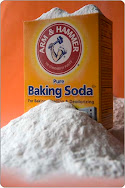Baking Soda
Brushing with baking soda, or bicarbonate of soda, is meant to counteract high levels of acidity in the mouth, a possible cause of bad breath. It is also used to whiten teeth when brushing.
History
Food historians believe the use of baking soda dates back to ancient civilization and it is perhaps this age-old use of it which has prevented its demise as a chemical additive.
Until the late 1700's, yeast was the main leavening ingredient used. However once it became widely accepted that bicarbonate of soda would create carbon dioxide gas in the presence of certain acids, housewives began making their own chemical leavening. Although the rising process was faster, it was a little hit and miss due to the majority of the leavening gases being released in the bowl (at the bench stage).
By 1835 the first baking powder compound had been created with the addition of Cream of Tartar. It was found that it gave more consistent results although it was more expensive than bicarbonate of soda and had a shorter shelf life. Experimentation continued and by the 1850s the Cream of Tartar was replaced with calcium phosphate which, whilst cheaper than Cream of Tartar, still produced most of the gas at the bench stage. The first Modern day, commercially prepared baking powder was born.
However, it wasn't until 1885 when sodium aluminium sulphate was discovered. This acid reacted only when heat was applied. The combination of Bicarbonate of Soda, different acids plus cornflour to keep the mixture more viable in storage, revolutionised baking powder.
Of course, that wasn't the end of it. Not only was baking powder added to flour to create Self Raising Flour, but also further refinements and experimentation have taken place over the years and today, we are left with a stable and dependable product.
Baking Soda and Baking Powder in cooking
One of the oldest usages of baking powder/soda is in the making of Soda Bread which is widely associated with Ireland. This is a leavened bread which, because of the use of baking soda/powder rather than yeast can be very quickly made cutting out the need for heavy kneading or proving time. This makes up for the fact that it doesn't keep fresh for very long.
Another old use is the addition of baking soda when cooking green vegetables in order to keep them greener. However this is no longer encouraged as it has been found that vitamins B1 and C are lost through this practice.
By far the most popular use of these ingredients is in cakes and baked goods as a leavening agent, however another, lesser known use is to lighten certain batters, in particular tempura batters which are required to be ultra light, crisp and thin.



